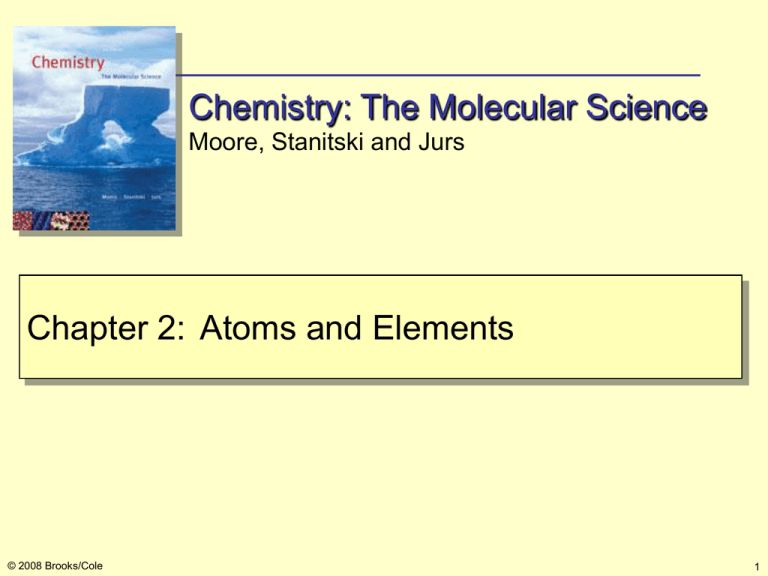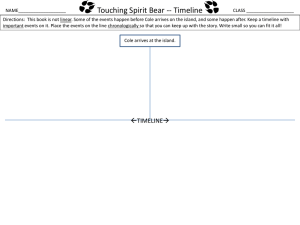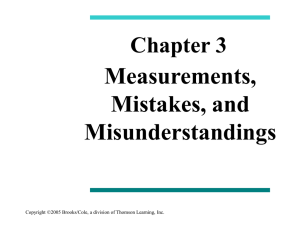Chapter 2 Atoms and Elements
advertisement

Chemistry: The Molecular Science Moore, Stanitski and Jurs Chapter 2: Atoms and Elements © 2008 Brooks/Cole 1 Atomic Structure and Subatomic Particles Atoms are composed of subatomic particles: • electron (e-), proton (p+) and neutron (n0). Key discoveries: Radioactivity Becquerel (1896) • U ore emits rays that “fog” a photographic plate. Marie and Pierre Curie (1898) • Isolated new elements (Po & Ra) that did the same. • Marie Curie called the phenomenon radioactivity. © 2008 Brooks/Cole 2 Radioactivity Electrical behavior: “+” attracts “-” but like charges repel Radioactive material β-particles (“–”) Beam of , , and Gamma ray (γ) No charge, no deflection Electrically charged plates α-particle (“+” ) Heavier, deflected less than β Atoms must contain smaller sub-units. © 2008 Brooks/Cole 3 Electrons Thomson (1897) discovered the e-: “Cathode rays” – high voltage + fluorescent screen cathode ray • Travel from cathode (-) to anode (+). • Negative charge (e−). • Emitted by cathode metal atoms. Electric and magnetic fields deflect the beam. • Gives mass/charge of e- = −5.60 x 10-9 g/C • Coulomb (C) = SI unit of charge © 2008 Brooks/Cole 4 Electrons Millikan (1911) studied electrically-charged oil drops. © 2008 Brooks/Cole 5 Electrons Charge on each droplet was: n (−1.60 x 10-19 C) with n = 1, 2, 3,… n (e- charge) Modern value = −1.60217653 x 10-19 C. = −1 “atomic units”. These experiments give: mass me = charge x charge = (-1.60 x 10-19 C)(-5.60 x 10-9 g/C) = 8.96 x 10-28 g Modern value = 9.1093826 x 10-28 g © 2008 Brooks/Cole 6 Protons Atoms gain a positive charge when e- are lost. Implies a positive fundamental particle. Hydrogen ions had the lowest mass. • Hydrogen nuclei assumed to have “unit mass” • Called protons. Modern science: mp = 1.67262129 x 10-24 g mp ≈ 1800 x me. Charge = -1 x (e- charge). = +1.602176462 x 10-19 C = +1 atomic units © 2008 Brooks/Cole 7 The Nuclear Atom How were p+ and e- arranged? Thompson: • Ball of uniform positive charge, with small negative dots (e-) stuck in it. • The “plum-pudding” model. 1910 Rutherford fired α-particles at thin metal foils. Expected them to pass through with minor deflections. © 2008 Brooks/Cole 8 The Nuclear Atom But … some had large deflections. α particles Rutherford “It was about as credible as if you had fired a 15-inch shell at a piece of paper and it came back and hit you.” © 2008 Brooks/Cole 9 The Nucleus Most of the mass and all “+” charge is concentrated in a small core, the nucleus. ≈10,000 times smaller diameter than the entire atom. e- occupy the remaining space. α particles © 2008 Brooks/Cole 10 Neutrons Atomic mass > mass of all p+ and e- in an atom. Rutherford proposed a neutral particle. Chadwick (1932) fired -particles at Be atoms. Neutral particles, neutrons, were ejected: mn ≈ mp (0.1% larger). mn = 1.67492728 x 10-24 g. Present in all atoms (except normal H). © 2008 Brooks/Cole 11 The Nuclear Atom Nucleus • Contains p+ and n0 • Most of the atomic mass. • Small (~10,000x smaller diameter than the atom). • Positive (each p+ has +1 charge). Electrons • Small light particles surrounding the nucleus. • Occupy most of the volume. • Charge = -1. Atoms are neutral. Number of e− = Number of p+ © 2008 Brooks/Cole 12 Scanning Tunneling Microscopy © 2008 Brooks/Cole 13 Scanning Tunneling Microscopy Fe atoms arranged on Cu. “Atom” (Chinese characters) © 2008 Brooks/Cole 14 Sizes of Atoms and Units Atoms are very small. • 1 tsp of water contains 3x as many atoms as there are tsp of water in the Atlantic Ocean! Impractical to use pounds and inches... Need a universal unit system • The metric system. • The SI system (Systeme International) - derived from the metric system. © 2008 Brooks/Cole 15 Metric Units • A decimal system. • Prefixes multiply or divide a unit by multiples of ten. Prefix mega kilo deci centi milli micro nano pico femto © 2008 Brooks/Cole M k d c m μ n p f Factor Example 106 1 megaton = 1 x 106 tons 103 1 kilometer (km) = 1 x 103 meter (m) 10-1 1 deciliter (dL) = 1 x 10-1 liter (L) 10-2 1 centimeter (cm) = 1 x 10-2 m 10-3 1 milligram (mg) = 1 x 10-3 gram (g) 10-6 1 micrometer (μm) = 1 x 10-6 m 10-9 1 nanogram (ng) = 1 x 10-9 g 10-12 1 picometer (pm) = 1 x 10-12 m 10-15 1 femtogram (fg) = 1 x 10-15 g 16 Metric Units How many copper atoms lie across the diameter of a penny? A penny has a diameter of 1.90 cm, and a copper atom has a diameter of 256 pm. 1 pm = 1 x 10-12 m ; 1 cm = 1 x 10-2 m -2 m 1 pm 1 x 10 1.90 x 1010 pm = 1.90 cm x x 1 x 10-12 m 1 cm Number of atoms across the diameter: 1.90 x 1010 pm x 1 Cu atom = 7.42 x 107 Cu atoms 256 pm © 2008 Brooks/Cole 17 Some Common Unit Equalities Length 1 kilometer = 0.62137 mile 1 inch = 2.54 cm (exactly) 1 angstrom (Å) = 1 x 10-10 m 1 gallon = 1000 cm3 = 1000 mL = 1.056710 quarts = 4 quarts = 8 pints 1 amu 1 pound 1 ton (metric) 1 ton (US) = 1.66054 x 10-24 g = 453.59237 g = 16 ounces = 1000 kg = 2000 pounds Volume 1 liter (L) Mass © 2008 Brooks/Cole 18 Some Common Unit Equalities Report the mass of a 5.0 lb bag of sugar in kilograms. 1 lb = 453. g 5.0 lb x 453. g 1 lb = 2265 g = 2.3 x 103 g = 2.3 kg © 2008 Brooks/Cole 19 Some Common Unit Equalities A patient’s blood cholesterol level measured 165 mg/dL. Express this value in g/L 1 mg = 1 x 10-3 g ; 1 dL = 1 x 10-1 L -3 g mg 1 x10 = 1.65 g/L 165 x 1 dL x 1 x10-1 L dL 1 mg © 2008 Brooks/Cole 20 Uncertainty and Significant Figures All measurements involve some uncertainty. Reported numbers include one uncertain digit. Consider a reported mass of 6.3492 g • Last digit (“2”) is uncertain • Close to 2, but may be 4, 1, 0 … • Five significant figures in this number. © 2008 Brooks/Cole 21 Uncertainty and Significant Figures Read numbers from left to right. Count all digits, starting with the 1st non-zero digit. All digits are significant except zeros used to position a decimal point (“placeholders”). 0.00024030 placeholders significant significant 5 sig. figs. (2.4030 x 10-4) © 2008 Brooks/Cole 22 Uncertainty and Significant Figures Number Sig. figs. 2.12 3 4.500 4 0.002541 4 0.00100 3 500 1, 2, 3 ? Comment on Zeros Not placeholders. Significant. Placeholders (not significant). Only the last two are significant. Ambiguous. May be placeholders or may be significant. 500. 3 Add a decimal point to show they are significant. 5.0 x 102 2 No ambiguity. © 2008 Brooks/Cole 23 Significant Figures in Calculations Addition and subtraction Find the decimal places (dp) in each number. answer dp = smallest input dp. Add: 17.245 + 0.1001 17.3451 dp = 3 dp = 4 Rounds to: 17.345 (dp = 3) © 2008 Brooks/Cole 24 Significant Figures in Calculations Subtract 6.72 x 10-1 from 5.00 x 101 Use equal powers of 10: 5.00 x 101 – 0.0672 x 101 4.9328 x 101 Rounds to: 4.93 x 101 © 2008 Brooks/Cole dp = 2 dp = 4 dp = 2 25 Significant Figures in Calculations Multiplication and Division Answer sig. fig = smallest input sig. fig. 17.245 x 0.1001 1.7262245 Rounds to: 1.726 sig. fig. = 5 sig. fig. = 4 sig. fig. = 4 Multiply 2.346, 12.1 and 500.99 = 14,221.402734 Rounds to: 1.42 x 104 (3 sig. fig.) © 2008 Brooks/Cole 26 Rules for Rounding Examine the 1st non-significant digit. If it: • > 5, round up. • < 5, round down. • = 5, check the 2nd non-significant digit. round up if absent or odd; round down if even. Round 37.663147 to 3 significant figures. last retained digit 2nd nonsignificant digit Rounds up to 37.7 1st nonsignificant digit © 2008 Brooks/Cole 27 Rules for Rounding Round the following numbers to 3 sig. figs. Number 2.123 51.372 131.5 24.752 24.751 0.06744 © 2008 Brooks/Cole 1st non-sig. digit 2.123 51.372 131.5 24.752 24.751 0.06744 2nd non-sig. digit 51.372 24.752 24.751 - Rounded Number 2.12 51.4 132. 24.7 24.8 0.0674 28 Rules for Rounding dp = 5 dp = 3 Answer dp = 3. 92.803 is the significant result. (5 sig. figs). 92.80344 99.12444 – 6.321 = = 3.37153195571 27.5256 27.5256 6 sig. figs. Significant figures? © 2008 Brooks/Cole = 3.3715 (5 sig. figs.) 29 Rules for Rounding To avoid rounding errors Carry additional digits through a calculation. Use the correct number of places in the final answer. Note Exact conversion factors: (100 cm / 1 m) or (2H / 1 H2O) Have an infinite number of sig. figs. © 2008 Brooks/Cole 30 Atomic Numbers & Mass Numbers Same element - same number of p+ Atomic number (Z) = number of p+ Atomic mass unit (amu) = contains 6 p+ and 6 n0. 1 12 (mass of C atom) that 1 amu = 1.66054 x 10-24 g Particle e− p+ n0 © 2008 Brooks/Cole Mass (g) 9.1093826 x 10-28 1.67262129 x 10-24 1.67492728 x 10-24 Mass (amu) 0.000548579 1.00728 1.00866 Charge (atomic units) −1 +1 0 31 Atomic Numbers & Mass Numbers The sum of the number of p+ and n0 in an atom is: A = mass number A ≈ mass (in amu) of an atom For element X, write: or or A ZX A X X-A e.g. e.g. 12 6 12 C C e.g. carbon-12 (Z is constant for a given element) © 2008 Brooks/Cole 32 Atomic Numbers & Mass Numbers How many p+, n0 and e- are in the following elements: 63 29 Cu 25 27 Mg Al © 2008 Brooks/Cole 29 p+ = 29 e- (neutral atom: e- = p+) 63−29 = 34 n0 12 p+ = 12 e- (periodic table; neutral) 25−12 = 13 n0 13 p+ = 13 e27−13 = 14 n0 33 Mass Spectrometer © 2008 Brooks/Cole 34 Isotopes and Atomic Weight Isotopes Atoms of the same element with different A. • equal numbers of p+ • different numbers of n0 Hydrogen isotopes: deuterium (D) tritium (T) © 2008 Brooks/Cole 1 H 1 1 p+, 0 n0 2 H 1 3 H 1 1 p+, 1 n0 1 p+, 2 n0 35 Isotopes and Atomic Weight Most elements occur as a mixture of isotopes. Magnesium is a mixture of: 24Mg number of p+ number of n0 mass / amu © 2008 Brooks/Cole 12 12 23.985 25Mg 12 13 24.986 26Mg 12 14 25.982 36 Isotopes and Atomic Weight For most elements, the percent abundance of its isotopes are constant (everywhere on earth). The periodic table lists an average atomic weight. Example Boron occurs as a mixture of 2 isotopes, 10B and 11B. The abundance of 10B is 19.91%. Calculate the atomic weight of boron. © 2008 Brooks/Cole 37 Isotopes and Atomic Weights Boron occurs as a mixture of 2 isotopes, 10B and 11B. The abundance of 10B is 19.91%. Calculate the atomic weight of boron. Atomic mass = Σ(fractional abundance)(isotope mass) 10B 19.91 (10.0129 amu) = 1.994 amu 100 % abundance of 11B = 100% - 19.91% = 80.09% 11B 80.09 (11.0093 amu) = 8.817 amu 100 Atomic weight for B = 1.994 + 8.817 amu = 10.811 amu © 2008 Brooks/Cole 38 Isotopes and Atomic Weight Periodic table: 5 B © 2008 Brooks/Cole Atomic number (Z) Symbol Boron Name 10.811 Atomic weight 39 Amounts of Substances: The Mole A counting unit – a familiar counting unit is a “dozen”: 1 dozen eggs = 12 eggs 1 dozen donuts = 12 donuts 1 dozen apples = 12 apples 1 mole (mol) = Number of atoms in 12 g of 12C • Latin for “heap” or “pile” • 1 mol = 6.02214199 x 1023 “units” • Avogadro’s number © 2008 Brooks/Cole 40 Amounts of Substances: The Mole A green pea has a ¼-inch diameter. 48 peas/foot. (48)3 / ft3 ≈ 1 x 105 peas/ft3. V of 1 mol ≈ (6.0 x 1023 peas)/(1x 105 peas/ft3) ≈ 6.0 x 1018 ft3 U.S. surface area = 3.0 x 106 mi2 = 8.4 x 1013 ft2 height = V / area, 1 mol would cover the U.S. to: 6.0 x 1018 ft3 8.4 x 1013 ft2 © 2008 Brooks/Cole =7.1 x 104 ft = 14 miles ! 41 Amounts of Substances: The Mole 1 mole of an atom = atomic weight in grams. 1 Xe atom has mass = 131.29 amu 1 mol of Xe atoms has mass = 131.29 g 1 He atom has mass = 4.0026 amu 1 mol of He has mass = 4.0026 g There are 6.022 x 1023 atoms in 1 mol of He and 1 mol of Xe – but they have different masses. … 1 dozen eggs is much heavier than 1 dozen peas! © 2008 Brooks/Cole 42 Molar Mass and Problem Solving Example How many moles of copper are in a 320.0 g sample? Cu-atom mass = 63.546 g/mol (periodic table) Conversion factor: 1 mol Cu = 1 63.546 g 1 mol Cu nCu = 320.0 g x = 5.036 mol Cu 63.546 g n = number of moles © 2008 Brooks/Cole 43 Molar Mass and Problem Solving Calculate the number of atoms in a 1.000 g sample of boron. nB = (1.000 g) 1 mol B 10.81 g = 0.092507 mol B B atoms = (0.092507 mol B)(6.022 1023 atoms/mol) = 5.571 1022 B atoms © 2008 Brooks/Cole 44 The Periodic Table Summarizes • • • • Atomic numbers. Atomic weights. Physical state (solid/liquid/gas). Type (metal/non-metal/metalloid). Periodicity • Elements with similar properties are arranged in vertical groups. © 2008 Brooks/Cole 45 The Periodic Table In the USA, “A” denotes a main group element… International system uses 1 … 18. …”B” indicates a transition element. © 2008 Brooks/Cole 46 The Periodic Table Main group metal Transition metal Metalloid Nonmetal © 2008 Brooks/Cole 47 The Periodic Table Period number A period is a horizontal row © 2008 Brooks/Cole 48 The Periodic Table Group 1A Alkali metals (not H) A group is a vertical column Group 7A Halogens Group 8A Noble gases Group 2A Alkaline earth metals © 2008 Brooks/Cole 49 The Alkali Metals and Alkaline Earth Metals Alkali metals (group 1A; 1) Alkaline earth metals (group 2A; 2) • Grey … silvery white colored. • Highly reactive. • Never found as native metals. • Form alkaline solutions. © 2008 Brooks/Cole 50 Transition Elements, Lanthanides & Actinides Transition Elements (groups 1B – 8B) • Also called transition metals. • Middle of table, periods 4 – 7. • Includes the lanthanides & actinides. Lanthanides and Actinides • Listed separately at the bottom. • Chemically very similar. • Relatively rare on earth. (old name: rare earth elements) © 2008 Brooks/Cole 51 Groups 3A to 8A Groups 3A to 6A • Most abundant elements in the Earth’s crust and atmosphere. • Most important elements for living organisms. Halogens (group 7A; 17) • Very reactive non metals. • Form salts with metals. • Colored elements. Noble gases (8A; 18) • Very low reactivity. • Colorless, odorless gases. © 2008 Brooks/Cole 52








